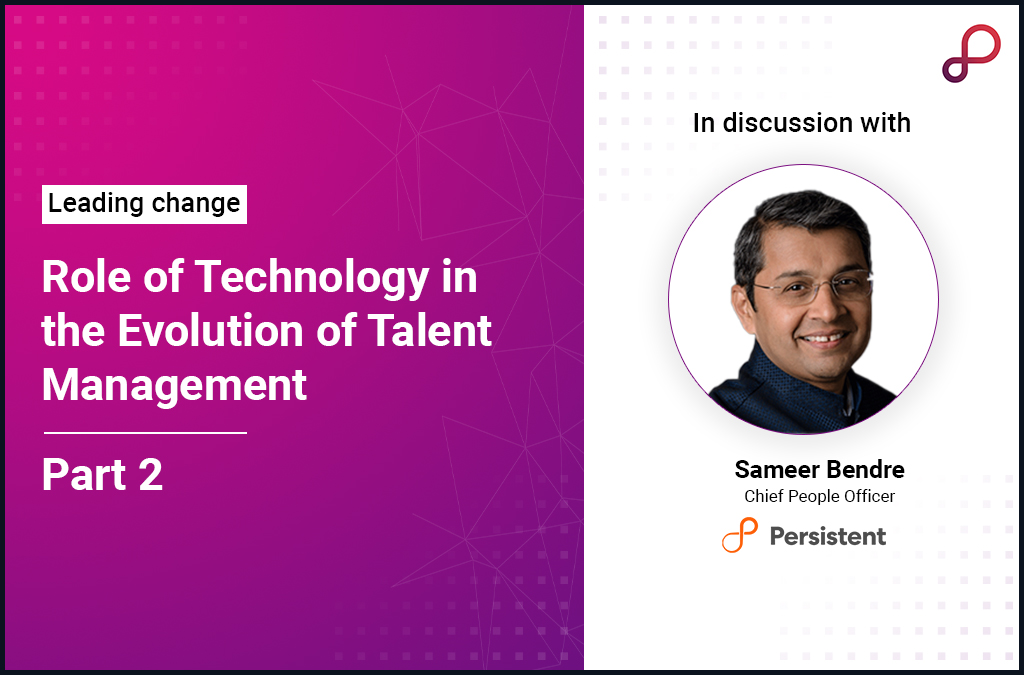08 Dec

Q – This is an interesting approach to handle talent management and work to help people grow within the organization. If you look at the start-up companies which are looking to grow, what do you think are the critical points they need to be aware of when planning their talent management? Are there any aspects which they typically tend to be ignore when planning a people management strategy?
I have been mentoring quite a few start-ups as I am a part of TIE, Nagpur. If there’s one thing about start-ups that I have constantly noticed, it is how they hire people based on how useful they are to them, on an immediate basis. They seldom plan and factor in the possibility of growth by 2X or 3X, or that they would grow from being a 20 people company to one employing a 60 or even 100 people. They need to ask a question- when needed is this person capable of managing such increased activity and scale up? Most cases, they realize that this person is not performing as expected.
Entrepreneurs need to note that with a start-up, they are on an accelerated journey. They need to onboard competent people who can stay on the journey and can remain with them for a sustained period and be able to deliver. These skills and abilities are what they need to consciously look for, when recruiting someone. They should not look for someone who is able to do what is required to be done today. They need to look for someone who can do what is required 6 months or even 18 months down the line. Otherwise, startups just end up paying tons of money and offering stock options to attract someone who fails to scale up, six or eight months later. Then, they realize that they need a new person, but they do not have deep enough pockets to make that change. Startups also need to look for people who are committed and willing to do whatever it takes to get something done and will not refuse to undertake some tasks or consider them either too simple or too hard, or just refuse to make the effort, when it is needed.
Start-ups need people who are ‘hungry’ and believe that they can do something different. They also need people who practice humility and can work with ease in teams, without any airs. They need to hire smart and intelligent people who can do their work well, but also be willing and ready to support others in the team who may be struggling. The stress is on teamwork and success for everyone around, and not on success for a single individual. Such an attitude and work ethic are important for a start-up.
Q – Will you need to look for these qualities before bringing someone in, as these are not qualities or habits that can be inculcated into someone, or skills that someone can be trained on?
Surely, not to a large extent.
It all depends on how the leader walks the talk. If the leader looks to get the best parking lot or the best laptop that gets purchased, the whole purpose gets defeated right there. They need to take the needs of the team into consideration and make sure that they meet the need. Maybe the data analytics person deserves the most powerful laptop, and not the CEO who needs a laptop to run Power point presentations in customer meetings.
By being smart in making such decisions, the leader can also show a sense of solidarity with the team and make them feel valued. Remember reading Simon Sinek, about how leaders eat last? That culture must come naturally to a leader.
You mean it is something a leader needs to demonstrate? I completely agree.
That’s the only way to make people who come in, to really understand what is valuable to the organization. Just to illustrate my point, when the pandemic started, I could also have said that I would be working from home and not coming to the office. But the teams had to come on and set up things for a VCP situation. At that time, I was here for a couple of hours every day. I helped them with whatever I could do. That helped them know that what they are doing is important. That’s the way leaders need to go.
Q – Taking the discussion back to your mention of high performers (HiPos)earlier, how systematic and objective can we be, when identifying them? Everyone wants the assessment to be a data driven process, which brings us to the key aspects of a performance management system, in enabling such an assessment.
My first question is this – How do you ensure that your teams are aligned to what the organization wants them to do? Secondly, how do you make sure that you are assessing their performance in an objective way? Thirdly, how are you creating HiPos out of them or assessing HiPos out of them, using processes which are acceptable to most people in the organization, without friction? I mean, if they feel that the whole identification assessment process is not fair, then it leads to different problems.
We were one of the companies which introduced continuous performance management early. Even before Adobe made it famous, we were already using continuous performance management. I think we have been using such a system over the last 11 years. We are all aware that there is an element of subjectivity in any performance appraisal. It may be 70:30 or it may be 80:20. Some part of performance management is always going to be subjective.
That subjectivity is with your leader, captain or whoever it maybe. You need to be candid and transparent about it and accept that there will be subjectivity. When you ask a manager to select 3 people out of their team of 10, they may not all be meeting the same performance criteria and even performing at the same level. At the same time, such a task cannot be managed with hundred percent objectivity. When you look at evaluating performance management at these levels, there will be other measures that are objective. You can measure them, whether it is your revenue performance, using the balanced score card, or the OKRs, derived out of it. So that’s one aspect of what you would call, transparency.
The other scores are there for everybody else to see. When you look at any objective-based performance measurement, there’s a very interesting or challenging problem. I have two people in my team. To one of them, I set the task of reaching the base camp of Mount Everest. To the other, I set the talk of going to a small hillock near my place. If I was in Nagpur, I would probably say, go to Ramtek and come back. This person can easily go to Ramtek and come back, five times if needed. From an objective measurement perspective, he has met his KRAs five times, making him a super performer. The guy who had to go the base camp of Mount Everest may not have managed to reach there due to a storm, but does that make this guy a star performer and the other guy a poor performer? Obviously not! Because the tasks set for them were quite different and cannot be compared without being contextualized. If the tasks were to be swapped, the first guy who was sent to the Himalayas would have easily gone to Ramtek five times and come back but the other guy may not have covered even half of what the first guy could.
Q – The task at hand or the goal that was set to the individuals is also important before you look at how much they have achieved.
Most times, it is impossible for us to clearly define the complexity of the goal.
The other thing which we have done in performance management is that we are in stage 1 of moving to a binary performance management scale. We used to be on a 5-point performance management scale, like most other companies. We’re currently on a three-point scale. Next year we are going to move to just a 2-point scale.
Q – Zero-One binary scale? That’s very interesting! How does that work?
We took some years to benchmark ourselves and set minimum levels to be able to say to someone that if you are at this scale, this guarantees your job in the company. If you’re not there, then you should not be employed in the company because you’re not performing. It’s like saying that, everybody applying for this exam must have a minimum 80% marks.
If you have 81 or 83, you still are above 80% marks. How do I slowly move from 80 to 85 and 85 to 90 so that my benchmark goes up, and my overall performance goes up? That’s the second part of the exercise.
Then the next question is how I take care of my special performers. I created something, which we call ‘contribution goals. When you do your job and do it well, we guarantee your salary. But you need to earn your bonus, by contributing to the organization. Organizations move ahead when employees move beyond what they need to do as a normal part of their job. We set direction by creating a list of tasks which would count as carrying a contribution.
These tasks go beyond your day-to-day tasks. They are not part of your day to day job. You do that as a contribution that tells me that you have done something which is beyond. It is mandatory for everybody at a senior level to offer some contribution. If I’m in software development, I do my software coding, but maybe I will also create some, repeatable or reusable code which can be used by five other people.
That means I have contributed to not only improve my efficiency, but also improved the efficiency of five other people. That’s my long-term contribution to the organization.
Very good. Interesting.
Even a pretty junior guy could come up and get involved in a big RFP proposal and contribute to it, though it is not expected from their job role. I may get involved in hiring people because it is an important challenge. If I do something to make things better, then it would be my contribution. My contribution could be on the technical side, it could be on the management side, or it could be on the enabling side. I pick the area of my contribution. I am not forced to contribute. If I do my job well, I’ll still earn my salary and I will get my normal increment.
Q – But there’s no contribution beyond that?
If two people do a great job on a project, the one that did a better job can demonstrate how the client sent more business their way because of the superior contribution offered by them.
Q – So, you’re linking that to your zero one binary scale?
This is all based primarily on the ISO 9000 philosophies.
You look at how ISO 9000 works, you’ll be asked to define, to do what you say and say what you do. When I do work, my product will be at a minimum at this benchmark. So, consistency is important here. I say, I will deliver this product within four days. If I deliver in three days, it doesn’t make it any better. If I deliver in five days and I have a problem. Your basic benchmarking is based on that. You make the rewards for contribution so attractive that over a period, 70% of the organization is looking to contribute something.
Q – This is interesting. I think this is the first time I’m hearing of an approach like this being tried in a large organization. It will be interesting to see how you achieved the results. Do talk of that as we move ahead.
We have always been persistent about looking at ourselves as an evolving HR. by evolving we refer to how we try out new things. If I fail, I tell my people that the experiment we tried didn’t work and that we can continue with our old ways of living.
Q – So, Sameer, one more question on this approach to trying out new things. I get the sense here that unlike many other large organizations, you are always thinking about people’s performance, how it contributes to the organization’s performance. You seem to be always innovating and looking at new ways, and then ways to refine that process. Is this something a part of your leadership team continuously and consciously keeps thinking about? Do you take any outside help to do the brainstorming? How does it happen?
Outside help certainly comes occasionally. I think a lot of credit goes to our CEO. He is an entrepreneur, a very strong techie who can write code if needed and he is also a great sales guy.
Q – Oh, excellent. All the great qualities rolled into one.
Yes. He is keen that we are not bureaucratic in applying this framework to people. He insists that such approaches need to aid people to be able to do different things, but not to hinder them. A lot of our thought processes have come from that philosophy. Our people have picked up many things, over the years. We have created our own HR product called eMee. I don’t know if you have heard of it.
So basically, we created a whole performance management system. The whole thing is like a game, using the concept of living on a farm. In the game, everybody’s given a house or a farm or some land. You do good things. They grow, but when you do bad stuff, things go away from you. Your house can become bigger when you do well. If you do something bad, the flowers may start shriveling. It’s all a gamified performance management ideation.
We also have, what we call a mood indicator in our office. When you come into the office, you can say, ‘today I am sad or unhappy. It may have nothing to do with the company. It could be that you are falling short of funds to buy that newly launched bike you wanted, or something happened at home to upset you.
Then someone, his manager or someone from HR can reach out to you or talk to you about these things and ensure that they are in a better frame of mind, happy at work and performing better. Sometimes, work can be too boring, or customers can irritate you and other things can happen at work. This indicated the hotspots in the organization and how people are feeling. Of the 11000 people in the company, about 2000 people change their moods in a day.
That’s an important data.
Maybe I don’t change my mood setting every day, but there are some people who do. Some people may change it every day. It is good for the organization to know when somebody needs us to reach out.
Q – Do you create some heatmaps or something similar in the organization, using this information? This innovative thinking and the importance given to this thought process comes to you right from the top and enables you to implement new frameworks and try things out.
Yes. That’s right.
Q – So, in all the interactions we have had with organizations, the point of how you justify investments in HR is always a big question. In your case, it would be the fact that the top management is convinced. In fact, when it’s a part of the DNA, the question of why you should invest in HR, never comes up! Your thoughts?
Yes. I think we can safely say that.
Q – Okay. But are there any points that you really need to look at when you are taking investment decisions in HR? For example, if you were to implement a new system or something like that?
I’d say we are a very interesting company in that we are a technology company. A lot of these technology developments have been already happening in house. To some extent, there is always a build versus buy because people want to build. We are also a very frugal company. You don’t want to just throw more money at things. I do want to do the right thing. When investment requirements come in nine different things, people must think through and pick minimum, total requirements.
To take a current example, we are dealing with the pandemic for over 6 months. I have a group which works with me on what we call ‘beyond work’ initiatives. These could be ‘fun at work’ initiatives, yoga training and may use external experts. People think about these programs and talk about them. I have run these initiatives over the last six months with zero budget. Of course, we are not counting the salaries of people who are running them. But the other expenses are at zero. For this, we have been able to attract good people not only internally, but experts who want to give a talk, educate people after seeing the platform, run sessions for them or educate them. We provide the people and the framework and use the infrastructure as our strength. When I need to invest in something and spend money, we think it through, as it’s in our DNA to analyze such spends.
Q – My question was more on, what parameters would you use to justify the investment? You will obviously, evaluate things very carefully. Check whether it requires external or more funding, and whether it can be done internally. My question was more about HR systems. What parameters do you use to evaluate maybe, a couple of them, which are the top of your mind? It’s typically difficult to quantify. That’s a challenge most people face.
My standard answer would be that it depends on the ROI I see when I adopt something.
Q – Yeah. But how would you define that ROI?
Some critical questions I would ask are – Will it be beneficial to all concerned? Will it improve my productivity, or will it improve my camaraderie in the organization? Will it bring that person closer to the organization if I do this for him? Will she be more excited about working with us, invite her best friends to join us, because we did this for her?
One more very important question here would be, is it the right thing to do? For example, we have taken out special Coronavirus coverage for all our employees, apart from the regular coverage. This is not only for our employees; it’s done for our contractors and vendors too. Doing it for everybody involved a substantial cost. But was it the right thing to do? I don’t think anybody will doubt that!



